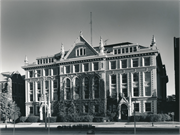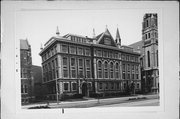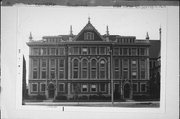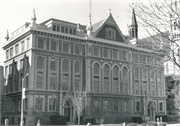| Additional Information: | A 'site file' exists for this property. It contains additional information such as correspondence, newspaper clippings, or historical information. It is a public record and may be viewed in person at the Wisconsin Historical Society, State Historic Preservation Office.
Another map code is 20/26 LUQS #398.
DESCRIPTION:
Johnston Hall is a Gothic-ornamented classroom structure designed by Milwaukee architect Charles D. Crane and completed in 1907. It was built by Jas. Quinn with masonry work done by Ernest and Winter. (A). The four-story, irregular L-shaped building fronts on Milwaukee's main thoroughfare, Wisconsin Avenue, and is sited directly east of Gesu Church. Johnston Hall's facade is divided into three equal bays, each four windows wide with a slightly projecting center bay. The windows on the seond and third stories are united under pointed arches in the central bay and bordered by rectangular, stone surrounds in each of the side bays. Prominent cornices also reinforce this visual emphasis on the middle two stories. Rectangular, double-hung sash windows are used throughout the building. The mottled grey brick is trimed with Bedford stone foundations, lintels, surrounds, and quoins and with a sheet metal modillioned cornice. An entrance is located in each of the side bays, enframed by Gothic arches and finials. The uppermost portion of the building is crowned by a gable with crockets and finials. Finials also accent the corners of the roof. Dormer windows are located on either side of the gable. The interior features marble wainscoting in the vestibule and on some stairs, but is otherwise finished in exposed concrete. Johnston Hall originally was divided into a multitude of spaces: a chapel, a reading room, parlors, administrative offices, a lunch room, a two-story library, and laboratories for physics and chemistry. An observatory was located on the roof. Jesuit teachers were once housed in the south wing and, additionally, in the attic after remodeling was done in 1938. Johnston Hall today houses Marquette's College of Speech and also Student Publications. The building is currently in excellent condition.
Johnston Hall occupies all of its site with only a small front yard. It is minimally landscaped with foundation plantings. The building in form and appearance has remained virtually unchanged since the 1938 remodelling of the attic level into living quarters.
ARCHITECTURAL/ENGINEERING SIGNIFICANCE:
Marquette University's Johnston Hall is a significant institutional example of a Gothic style unique in Milwaukee. While English-derived Collegiate Gothic specimens abound on Marquette's campus (1920s), the former Milwaukee-Downer College (1897-1905, now UW-Milwaukee) and in Milwaukee's public school (1912-1920s), Marquette's Johnston Hall is an eclectic structure combining Renaissance and Gothic motifs. Stylistically, Johnston Hall occupies a spot between Milwaukee's Late Picturesque Gothic of the 1890s and the more archaeologically correct manifestation of Gothic popular from the early 1900s to the Depression. Johnston Hall, however, is much more a product of the earlier Victorian manifestations of the Gothic style.
Johnston Hall, in addition to its stylistic distinction, holds a unique place in Milwaukee's engineering history as the city's first structure to extensively use reinforced concrete both as an interior finish as well as for structural purposes. With the exception of marble wainscoting in the vestibule and some stairways, the interior concrete partitions were left exposed in order to economize on construction costs.
Johnston Hall was architect Charles D. Crane's only experimentation with the Gothic style. During the first decade of this century, Crane worked mostly in the Georgian Revival style. Crane is better known for the work he did earlier in partnership with Carl Barkhausen which was of Germanic stylistic orgins. Interestingly enough, Crane released drawings to four area newspapers in 1908 of a building to match Johnston Hall to be built for Marquette's Law School on property to the west of Gesu Church. The building was never constructed, however, and Crane did no further work for Marquette University.
HISTORICAL BACKGROUND:
Marquette University, established in 1881, occupies a unique place in the history of Milwaukee's educational institutions. Although it was Milwaukee's first liberal arts university, it eventually also included such diverse fields of study as law, medicine, and engineering. In spite of the fact that it was established as a Catholic institution, Marquette's broad offering of classes has long attracted students from all religious backgrounds. From one building and 35 students in 1881, Marquette University has grown to encompass over 35 acres and has a current enrollment of over 12,000 students. Its Wisconsin Avenue location has put Marquette near the center of downtown activity and has provided a buffer zone along the Avenue between the high density commercial activity to the east and the smaller scale business and residential developement to the west.
Marquette's incorporation in 1864 and actual establishment in 1881 was the result of a campaign begun by Bishop Martin J. Henni of Milwaukee in 1848. In that year Bishop Henni toured Europe in the hope of receiving funds with which to start a school. A patron was found in the person of Chevalier Guillaume De Boey of Antwerp, a Belgian aristocrat with an interest in the burgeoning American Midwest. When a $16,000 bequest became available upon the Count's death in 1850, Henni made an unsuccessful attempt to obtain Jesuit priests to teach in the proposed school that he already planned to call Marquette College. The college plan remained dormant until 1857 when St. Aloysius Academy was founded with the hope that it would evolve into a college. Due to administrative difficulties, however, it never became more than a parochial school adjunct to St. Gall parish.
The incorporation of Marquette College in 1864 was an attempt to take advantage of the tax exempt status accorded schools. Bishop Henni had donated property for the establishment of the college in 1857 on State Street between 10th and 11th that had remained undeveloped. By incorporating a college, even though no school actually existed, Bishop Henni hoped that the diocese could avoid paying the $250 yearly property tax. The land was determined to be taxable anyway, however, and the constant tax expense for the college site was an even greater incentive to develop the property. Meanwhile, although characterized as a college, no actual educational facility existed and no classes were conducted. A parish church and parochial school (Holy Name) were built on the site in the late 1870's.
Bishop Henni's work was finally completed by the efforts of Rev. Stanislaus Lalumiere, S.J., who had come to Milwaukee in 1857 at Henni's request and eventually became the superior of the Milwaukee Jesuits. Although administrative difficulties and financial problems prevented a college from being established for seventeen years, Rev. Lalumiere became Henni's champion in this cause and in the late 1870's intensified his efforts to establish a college for Heni during the aling Bishop's lifetime. Through a successful subscription campaign, Rev. Lalumiere obtained the necessary funds and the first college building was constructed at Tenth and State Streets (razed). Cornerstone laying ceremonies were presided over by Henni's coadjutor and future successor Bishop Michael Heiss as Henni was too ill to attend. Dedication took place on August 28, 1881 and Henni died on September 8, 1881, just two days after classes started. The handsome new college structure cost $30,000, was four stories in height plus a basement and could accommodate 450 students. During the first year, the five Jesuit instructors also adminstered to the parishioners of Holy Name. They were housed in the college building and had dining facilities and a chapel there. 'Hilltoppers' was a nickname given to Marquette students during these early years, because the college was located at the crest of a prominent hill.
Student enrollment grew steadily throughout the years and the 1881 building soon became overcrowded. Needed space was made available when Holy Name parish vacated its adjacent buildings to become part of the congregation of the new Gesu Church in 1894.
Major changes in the educational program at Maquette took place about this time. The Jesuit liberal arts college plan as compiled in Europe in the 16th century and amended in 1832 provided for a seven-year course of study leading to a Bachelor of Arts degree. Admission was dependent upon a young man's knowledge of reading, writing and arithmetic. In the United States, this meant that boys often entered college after the eighth grade and could even apply sooner if exceptionally bright. Additionally study or attendance in a preparatory class was required for those who had not done well in grammar school. In the early years the curriculum at Marquette made no clear demarcation between the secondary and collegiate levels. Marquette began to offer a shorter commercial course that resulted in the granting of an Honroary Certificate rather than a degree.
In 1901-02 Marquette decided to separate its high school level students from its college courses. Competition from public high schools was a factor in this decision. In addition, this change made it easier for students to trasfer to other colleges, such as the University of Wisconsin, and also made the transition to graduate work smoother. Marquette was now educationally compatible with the programs of other American college and universities.
By 1906 the college student population had grown to 327. With the large number of high school students at the site as well, severe overcrowding occured at the State Street campus. A donation of $20,000 by baking magnate Robert A. Johnston gave Marquette the means to move to a new site adjacent to Gesu Church on Wisconsin Avenue. Milwaukee architect Charles D. Crane designed a new structure to serve as a combination classroom and Jesuit residence. When building costs exceeded the funds available, Johnston furnished the necessary money to complete the $110,000 building, which was subsequently named for him. In 1907 the college portion of the school moved into the new Johnston Hall while the high school students remained at the old State Street buildings.
Marquette's transition from a college to a university also came about at the time of the move. This was accomplished by its affiliation with the Milwaukee Medical College. The loose confederation of the two institutions allowed the medical school to operate its Trinity Hospital on Wells Street and to control its teaching programs while Marquette granted the degrees. This alliance came at a propitious time for medical education in Wisconsin as well as Milwaukee. Largely unregulated up to this point, medical schools were sometimes the province of fly-by-night instructors who cranked out "degrees" after a mere day's worth of lecturing. Most legitimate training in the medical field consisted of apprenticeships with local practitioners. Degrees could also be obtained from out-of-state institutions, only a few of which actually had university affiliations. Milwaukee Medical School's association with Marquette University lent an aura of respectability to the medical program and firmly established Milwaukee's importance as a medical education center.
In addition to the medical program, Marquette bolstered its role in professional education by acquiring a law program with the purchase of the Milwaukee Law School for $6,000in 1908. (Hamilton pp. 80-85) Marquette established the School of Engineering in 1908 thereby giving it a foothold in the three recongized secular professions of the period: medicine, law and engineering.
The first woman received her B.S. degree from Marquette in 1909 while the second received her degree in law in 1910. These women received their degrees from the tradtionally all-male university as a result of Marquette's acquisition of and affiliation with private schools of medicine and law. No specific policy decision was made to exclude women from Marquette, but the Jesuits wanted to avoid total co-education. Recognizing the growing demand for higher education for Catholic women, however, consideration was given to establishing a separate college for women to be run by nuns trained by the Jesuit staff. To accommodate the nus teaching schedule and to take advantage of the absence of male students, their training was to be accomplished through special classes held in the summer of 1909. This was the first summer school ever established at a Catholic institution. To the administration's surprise, lay women enrolled as well as nuns. Cancellation of the program was proposed by those opposed to admitting female students, but classes were allowed to proceed pending official word from Rome. A papal reply was slow in coming and in the interim, addition summer classes were held and Marquette affiliated with the Wisconsin Conservatory of Music, which had a great number of female students. Formal papal approval for the admission of women was granted in 1912. The separate college for women at Marquette never materialized, but summer classes and women students have been a common feature at the university ever since. By 1916, total enrollment included 375 women.
Marquette's academic expansion continued more less unabated through the early 20th century as schools of economics, journalism and business were added in 1910. Marquette established its own school of music in 1920 followed by the departmens of education and dental hygene in 1923. The first speech department of any Catholic university in the United States was established in 1922 and became a school in its own right in 1926. The first graduate program was offered in 1922 and in 1931 Marquette was approved as a graduate institution by the Association of American Universities and received authorization to confer doctoral degrees. During this intense flurry of expansion in the 1920's Marquette constructed a gym, a men's union, a law building, a science building and a dental school building. Promienent Milwaukee architects such as Thomas R. Rose and Eschweiler and Eschweiler were employed to design the new buildings. Johnston Hall, which originally housed the liberal Arts College and Colleges of Economics and Journalism remained the center for Liberal Arts as the various other colleges found new quarters and eased the overcrowding at the 1907 building.
Marquette's expansion extended into its high school and medical facilities. A million dollar health complex was proposed for the site of the old Schandein Estate at 24th and Wisconsin. It would have provided emergency service, a 500-bed hospital and facilities to house 300 student nurses. A proposed college of hospital administration there would have made this the only teaching center of its kind in the world. Legal opposition to the plan by the county prevented the scheme from becoming a reality. The high school project met with greater success. A $100,000 donation from the Johnston family enabled Marquette to construct a new high school which was dedicated in 1925. Although originally intended for a site at 13th Street and Wisconsin, the new high school was ultimately built away from campus at 34th Street and Wisconsin. Marquette University retained control of the high school until 1950 when the school was given an independent Jesuit staff and autonomy from the university. The high school continues to operate under Jesuit administration today and is known for its maintenance of high academic standards.
The decades of the 1930's and 1940's were plagued by financial difficulties and the loss of some departments, including music, as Marquette struggled through the Depression and war years with declining enrollments and reduced benefactions. The 1950's, however, witnessed a post-war veteran enrollment boom and another building spurt as overcrowing and long-deferred maintenance took their toll on campus structures. A new student union, library and business administration building were constructed during the 1950's. These structures were the first to deviate from the Collegiate Gothic design of the old campus and paved the way for later buildings constructed in a variety of modern styles.
Marquette's most visible period of change, however, occurred in the 1960's and early 1970's. It was during this period that Marquette made a profound impact on the pysical appearance of West Wisconsin Avenue as well. Taking advantage of Section 112 of the U.S. Housing Act of 1959 which authorized urban renewal projects for universities, Marquette and the City of Milwaukee entered into a controversial renewal plan whereby the university was to acquire some 35 acres of blighted property for campus expansion. The success of the endeavor was the final step in enabling the school to establish the unified central campus that had been the goal of Marquette's leaders since the mid-teens. Unlike other urban university administrators of the period, the Jesuits, being an urban-oriented order, gave no thought to relocating the school to a new suburban campus. Rather, expansion was achieved by the acquisition of numerous surrounding parcels. Over the years this policy had serious consequences for some of the once grand mansions on Wisconsin Avenue. Beginning with the Plankinton Estate purchase in 1916, which included the palatial Victorian residences of John and William Plankinton, the school increasingly viewed Wisconsin Avenue as its territorial perogative. Procurement of all of the land between Johnston Hall and the Plankinton Estate at 15th Street was soon made the long range goal. Numerouos mansions were purchased, used by the University, and ultimately razed to make way for new structures or campus open space.
By the 1960's, this piecemeal approach had proven too costly and too slow to accomodate Marquette's growth. Urban renewal allowed the city to use condemnation powers to acqure and raze all non-conforming buildings in the designated area and sell the cleared land to Marquette. In response to the newly available land, a new campus plan was adopted in 1962 and modified through 1967 that divided the newly unified campus into service zones. The area bounded by West Wisconsin, Clybourn, 12th and 16th Streets was designated as the academic zone. New construction would be oriented away from Wisconsin Avenue and clustered around a central mall that would be visible from the newly constructed freeways I-43 and I-94 which formed the east and southeast boundaries of the university. A residential zone containing dormitories would be located between Wisconsin Avenue, 16th Street, Kilborun and 11th Street. A recreation zone was established at the northwest corner of Clybourn and 16th Streets. Parking areas were located at the perimeter of the campus. The plan also called for the elimination of 33 obsolete buildings owned by the university, the construction of the thirteen new buildings (five academic, six residential, an elementary school and a Jesuit residence), additions to five existing buildings (union, library, dentistry, service and gymnasium buildings) and the erection of ten multi-level parking structures.
In the last two decades significant portions of the master plan have been implemented. Some 14 structures have either been constructed or enlarged, particularly on the southern fringes of the campus around the central mall. Although not much new student housing has been built, two former high rise motels nearby have been acquired for use as dormitories. Some aspects of the master plan have yet to be fulfilled, including the ten parking structures and a pedistrian bridge over Wisconsin Avenue at 14th Street. The residential zone currently remains unitegrated into the overall campus scheme since residence halls are scattered and separated by large tracts of undeveloped land. Only in the academic zone has Marquette University attained its goal of a mall-focused central campus.
HISTORICAL SIGNIFICANCE:
Marquette University's Johnston Hall is historically significant as an expression of the intense interest in higher education on the part of Wisconsin's Catholic community. Through the active recruitment of Jesuit priests, known for their comprehensive and rigorous teaching standards, Bishop Martin J. Henni provided a sound foundation for what was to become Milwaukee's first university. Unlike Marquette's religious contemporary, Concordia College, which remained a narrowly focused Lutheran pre-seminary training college through the 1950's or the State Normal School which served as a teacher's training college into the 1950's, Marquette by 1910 offered high quality education in a broad range of liberal arts and professional fields with classes open to all students, male or female, regardless of creed.
Marquette's era of expansion and prominence in Milwaukee began with its relocation in 1907 from 10th and State Street to its new facility on Wisconsin Avenue, Johnston Hall. In that same year Marquette received its charter to issue degrees as a university. Credit for Marquette's attainment of university status goes to Father A. J. Burrowes who was president of the liberal arts insitiution from 1901 to 1908. He successfully negotiated for the school's affiliation with Milwaukee Medical College in 1907 whereby university status was achieved. Burrowes set in motion Marquette's drive for the acquisition and establishment of the various schools for which it is known today, Law (1908), Engineering (1908), Journalism (1910), Busines Administration (1910) and others. Johnston Hall became a symbol of the new Marquette University. With the exception of medical clases which were held at the Trinity Hospital complex (razed), Johnston Hall accommodated all of the university's academic functions from Jesuit housing to a library and a student lounge. Johnston Hall was to remain Marquette's principal structure until the school's next major period of physical expansion in the 1920's. Financial constrains inhibited the university's expansion and almost prevented the completion of Johnston Hall. A timely donation by baking Magnate Robert A. Johnston enabled completion of the building which was subsequently named for him.
Ernest & Winter was the mason in 1906, and Jas. Quinn was the builder in that year.
1907 - Marquette received university status with the center of campus expansion and curriculum development eminating from Johnston Hall. |
|---|
| Bibliographic References: | A. Milwaukee City Building Permits.
B. Hamilton, Raphael N., S.J., "The Story of Marquette University." Milwaukee: Marquette University Press, 1953, pp. 3-9, 11, 16-22, 25, 41-42, 53-55, 95, 106, 124-127, 209-215, 249, 255. (Architect Source: Hamilton, p. 108).
C. Marquette University Archives. Campus Development Files.
D. "The Catholic Church in Wisconsin." (Milwaukee): Catholic Historical Publishing Company, 1897, p. 27.
E. Still, Bayrd, MILWAUKEE, THE HISTORY OF A CITY. (Madison, 1948), p. 419-417.
F. Helfer, Sebastian. Engrg. Services, Marquette University (May 8, 1980) |
|---|




